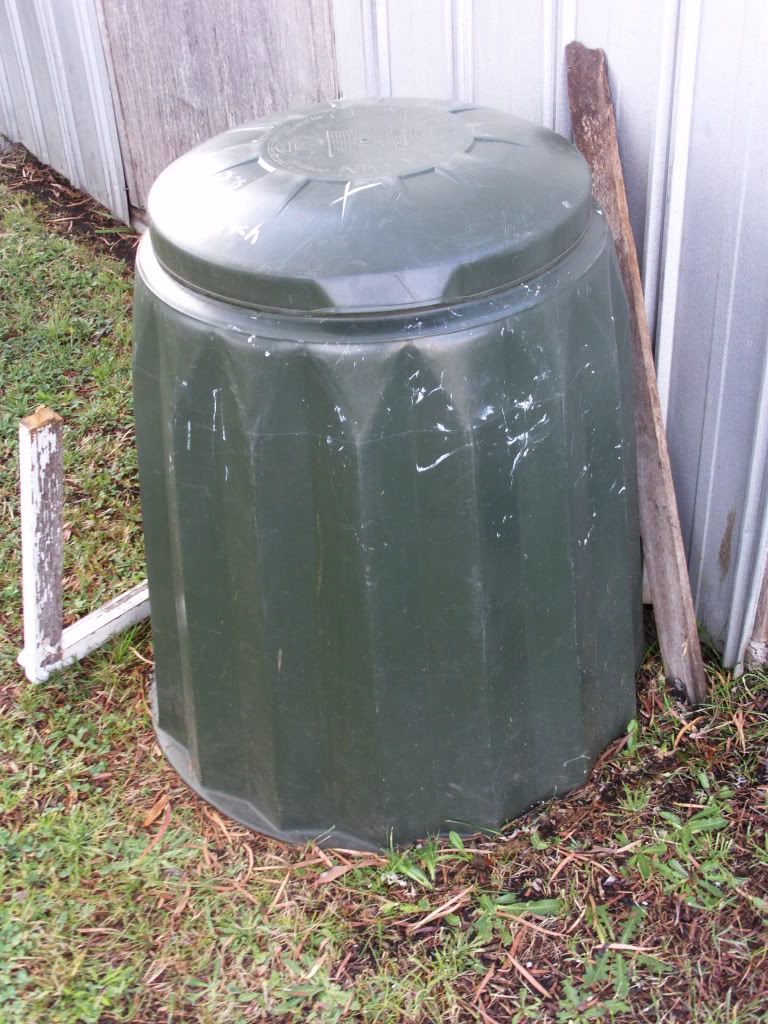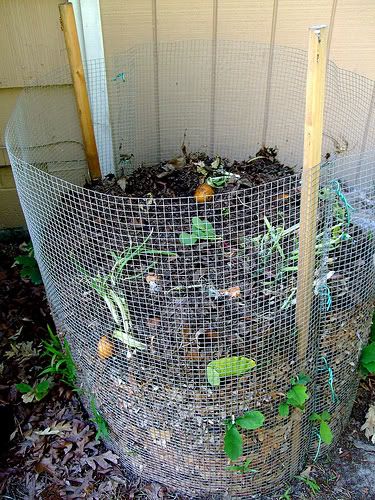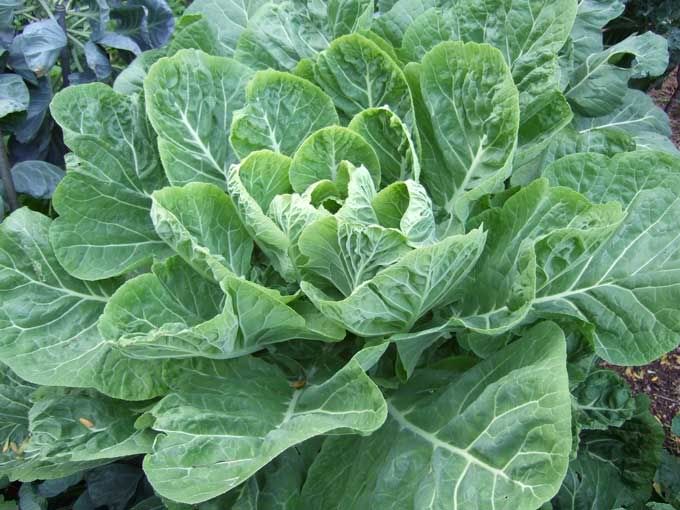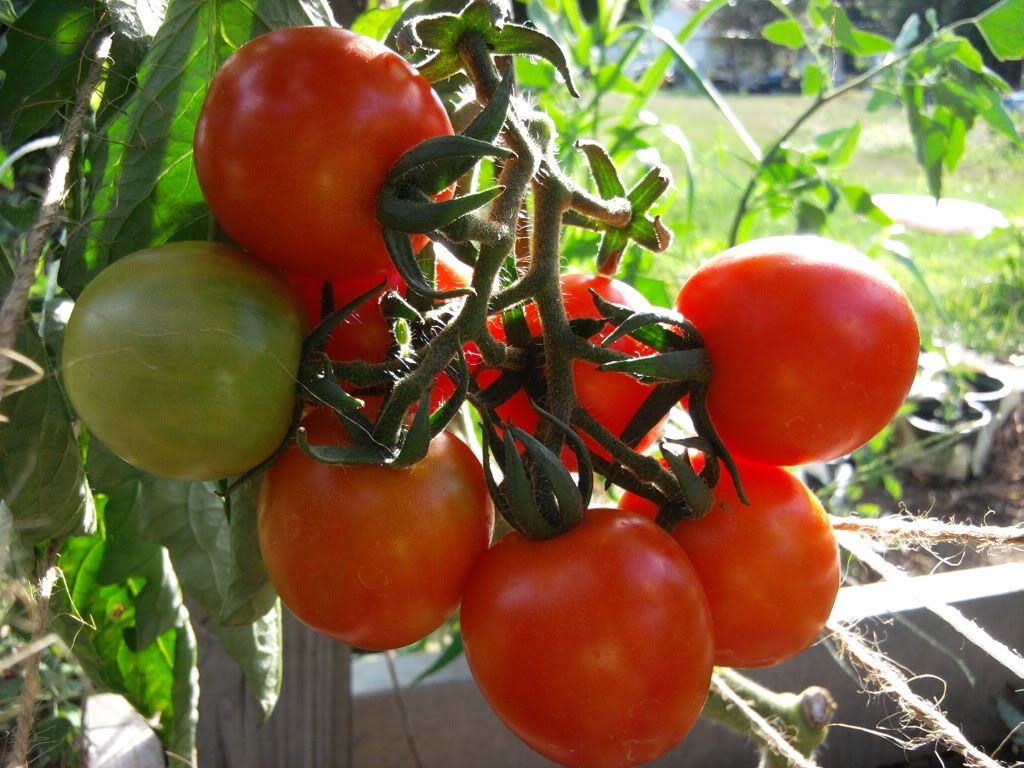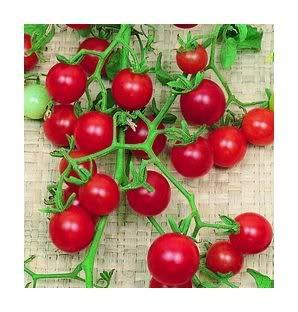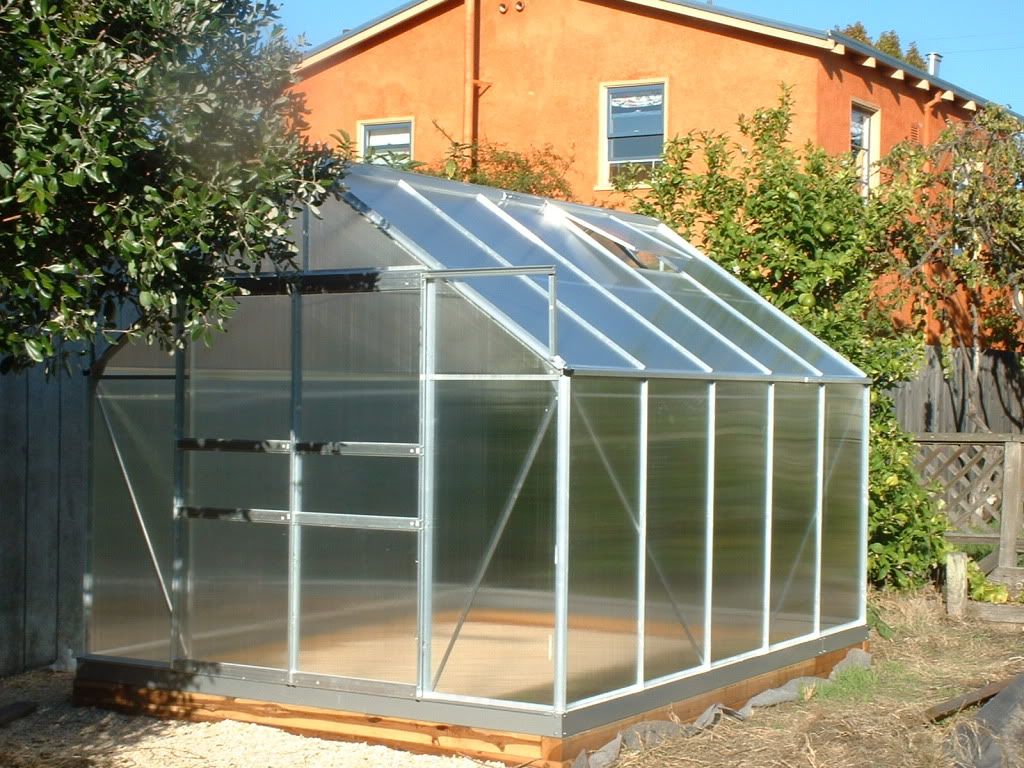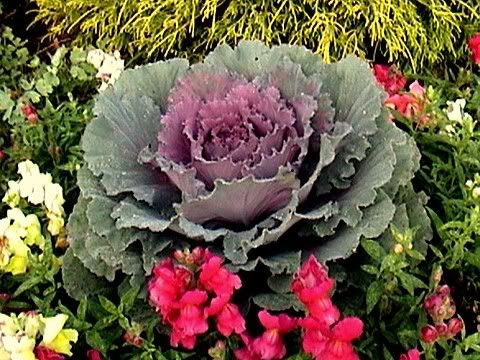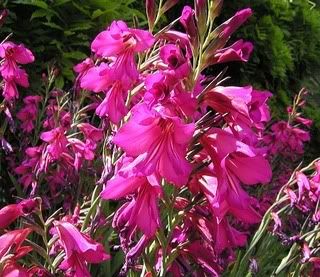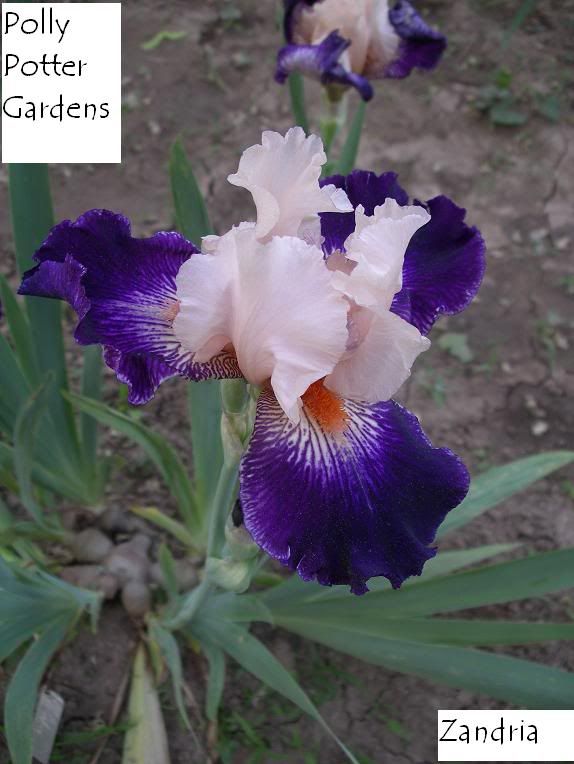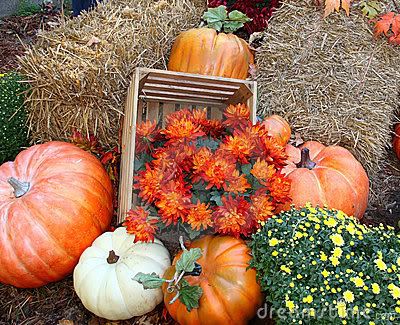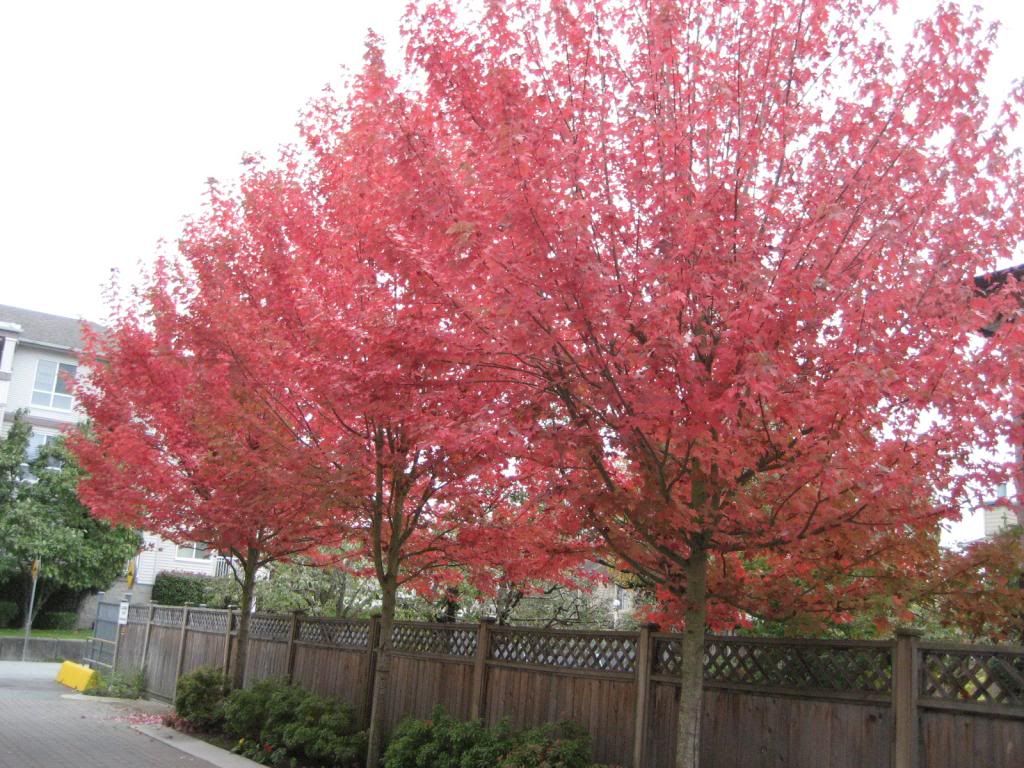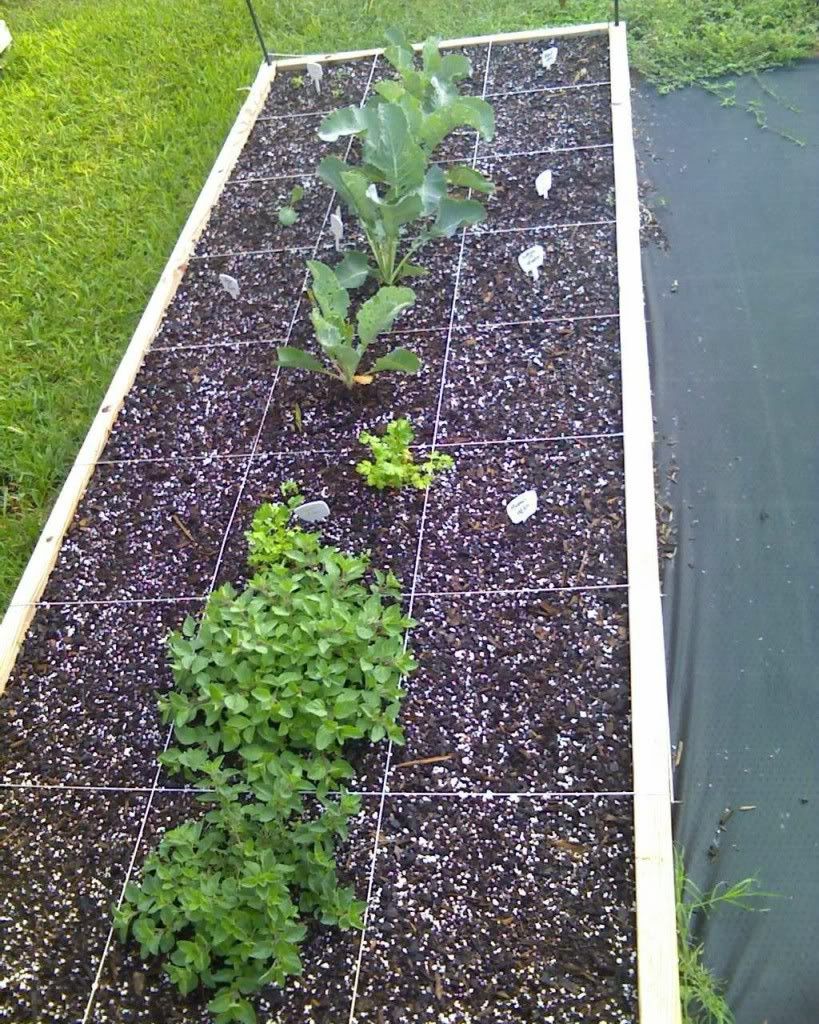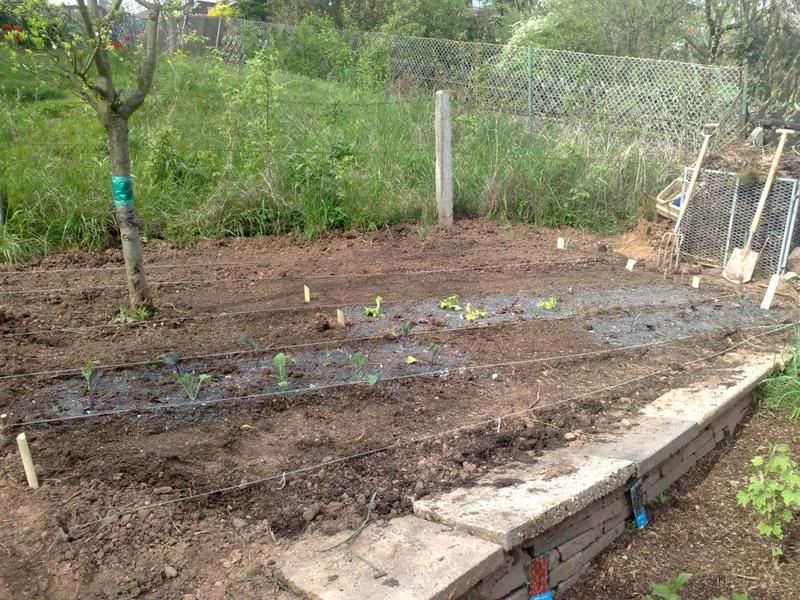Thursday, January 30, 2014
What Are The Gardener's List Of Tools?
There are many different kinds of tools that gardeners need to have to work in their garden.
There are so many different tools on the market that can be overwhelming to everybody.
It is important that I enjoy using my gardening tools, so comfort needs to be the first consideration. I always try out the garden tool for ease of handling before I buy it. The shaft of a fork, spade, or rake needs to be the right length so I do not have to stoop, and the hilt or handle should be easy to grasp when I am wearing gloves, the weight and balance should feel right.
Spade
I will need a spade to dig planting holes for shrubs, trees, and large herbbbbbbaceous plants. A spade is also used to spread any manure, compost, and mulching materials
The blade should be sharp. If I have a forged steel blades, then this one can be sharpened when they lose their cutting edge.
Digging is the hardest on the back, I always make sure my spade handle is long enough.
Watering can
Buy a 2-gallon watering can with a long spout that I can water all of my plants with it.
Trowel
Trowel is probably a tool that I will used the most for all of my weeding and planting. In buying a stainless steel trowel is the best thing to do. A second trowel with a narrow blade is useful for planting bulbs and also getting out weeds with taproots, such as dandelions.
Shears
I will need to have a pair of shears that I will need for flower gathering, dead-heading and pruning of branches up to 1/2 inch in diameter. The shear's handles need to be comfortable to grip, and they will not slip in my hand, always make sure that the handles do not open too wide for your handles. The safety catch of my shears need to be operated with one hand.
Mower
The kind of mower I need to get is according to what kind of jobs that I will be using the mower for a small, hand-operated push mower will cut in widths of about one foot and I can also get a tractor.
Clippers
I have hedges so I will need these shears are essential equipment. They are used to tidy up grass where my mower can not reach, against walls and around the base of trees and shrubs and for clipping plants such as lavender. Some people uses clippers to prune roses.
Summary
Since I want to plant a garden and a flower bed, the tools that I have talked, about in this article I will need to get from a store.
Labels:
clippers,
gardening,
mower,
pruning shears,
rake,
spade,
tools,
trowel,
watering can
What Shrubs Are Good For Fall Color?
Usually when a person think of fall colors, trees comes to many people's mind, like the beautiful leaves on a sugar maple, but there are many shrubs that have very beautiful leaves on them. Shrubs not only have beautiful leaves, they also have fruits and berries on some of the shrubs.
Shrubs have many advantages over trees. Most of the shrubs will cost less money than trees. Shrubs mature more quickly and they provide good color the first fall after they are planted. Some good reasons to have shrubs in your yard are they do double duty by providing barriers, screens, ground covers or spring flowers.
All the shrubs that I will be talking about in this article are easy-maintenance plants. They also offer great fall color and they are for all over the country. There may be many other shrubs that would be available in your area that I want be talking about in this article. Always talk to your negibos or garden centers where you are living in.
Cranberry bush has red autumn fruit. In the spring it has flat, lacy clusters of white flowers. In fall their leaves range from yellow to red-purple. It is hardy to 50 degrees F. and this shrub reaches up to 15 feet high and wide.
Cranberry cottoneaster is a low wide-spreading shrub that reaches up to three feet high and three to six feet wide. It has dark, glossy green foliage in the summer and it turns to red or purple in fall. These shrubs has bright red berries, and they usually fast for several months. This shrub is hardy to 30 degree F.
Dwarf fothergilla is grown mainly for its intense yellow and orange-red fall foliage. In the spring, its bears clusters of honey-scented white flowers. This shrub prefer acid soil and it is hardy to -30 degrees F.
Witch hazel grows very high and very wide something like 15 feet. The winter flowers range from yellow to orange to red. Some of the fall foliage will be a single color or a mixture of red, yellow, and orange on the same plant.
Rugosa roses are very hardy shrub roses that has prickly stems that will grow as high as 3 to 8 feet. This shrub also provides fragrant 3 to 4 inches blossoms and their colors are pink, white, and purplish red. In the fall, you will have bright red tomato-shaped fruit, about one inch or more across. It is real hardy to the degree of -50 degrees F.
Winterberry has crops of bright red fruit that ripen in fall and can last all winter. It is hardy to -30 degrees F.
Firethorns has large, dense clusters of pea-size fruits range from red to orange to yellow, depending on which type of shrubs you get.
Fragrant sumac has attractive three inch glossy green leaves that release a fragrance when you touched or crushed. It is hardy to -40 degrees F.
Heavenly bamboo has white flowers in midsummer and in the fall this shrub has orange-red pea-shaped fruit. It is hardy to 0 degrees F.
Summer sweet grows 10 feet tall. In the summer this shrub has white flowers on the branch tips. The 2 to 4 inches leaves turn yellow to golden in the fall. This shrub is -40 degrees hardy.
Burning bush has red fall foliage. The plant grows 15 to 20 feet wide and high. It is -30 degrees F hardy.
Japanese maples has delicate deeply cut leaves that grows 2 to 4 inch long. They are hardy to -20 degrees F. This spring growth is red, the summer leaves are soft green and the fall foliage is scarlet.
Oak leaf hydrangea has large, showy, cone-shaped clusters of white flowers in early summer and in the fall this shrub has eight inch oak like leaves that are either crisom or bronze. It is hardy to -20 degrees F.
Purple beaautyberry has clusters of 1/8 inch fruits in an unusual lilac violet color. In cold winter areas, these shrubs may freeze to the ground, but do not worry, it will come back from the roots. It is hardy to -20 degrees F.
Japanese barberry has small rounded leaves that turns yellow, orange, and red in fall. It is hardy to -30 degrees F.
Red choke berry grows up to six to eight feet high. In the summer this shrubs has bright red fruits in late summer and it does well into winter. Fall leaf color on this shrub is a bright red-purple that lasts for several weeks. Black choke berry has ripe fruit that it is blacklist purple. It is hardy to -30 degrees F.
Summary
There are many different shrubs that you can put in my yard to have so much pretty color for the fall.
Wednesday, January 29, 2014
What Are The Basic Skills Of A Good Gardener?
There are a few basic skills that I will need to learn to become a good gardener. Most of these skills will become second nature to everybody once I have learn the skills of being a good gardener, then gardening becomes easy.
Planting
Planting is the most important skill that I can learn. Some different ways that I can learn on how to plant are watching a very experienced gardener or to volunteer to get hands on experience.
To plant my newly purchased plants, dig a hole larger than the pots that the plants are in. I will need to turn the pots upside down with one hand and put my other hand underneath to catch my plants. Always try to get the plants out very slowly. Do not yank or pull the plant out by the stems. Always plant them at the same level that they was growing in the pot, but in a slight depression. Then I will need to pack the soil around the plant, this is done using only my hands.
As I plant each plant I will build up, a mud wall about two inches high around each plant. This will help to keep the moisture in. Then I will have to water each plant with a water hose very slowly until each plant thoroughly saturated. If you live in a cold winter area, you will need to fertilize every couple of weeks until July and then you will need to stop now so the plants can get ready for the cooler fall weather. With perennials you do not fertilize them when they are in their second year.
Transplanting
When I have a perennial that I want to divide and transplant it is best done in the early spring, just as the plant emerges. I can basically do it anytime expect during the summer heat. Dig the plant up and cut it in half or in several pieces depending on its size. I can use a spade or a kitchen knife. to do this.
Transplanting is like planting except I sometimes would like to shape up my plants. This means cutting back the top growth so the roots do not have to much to support while they are getting establishing themselves. This plant needs to end up at the same level that it was growing before it was started. Also I will need to create an earthen dam around the base to catch and hold the water. I will need to thoroughly soak the soil right after I plant them.
Growing From Seed
Sowing seeds is a whole lot less work , than planting. Some of the seeds, not all kinds of seeds, can be sprinkled over the soil I can either do this in fall or late winter with annuals such as poppies, bachelor's buttons, and larkspurs. Vegetable seeds are always planted in rows at the time that they are suppose to be planted. Take your rake, and dig and level the soil to create a furrow or so deep. Then I will plant my seeds like beans, corn, and peas or whatever I choose to plant now. I will cover the seeds about a 1/4" to 1/2" deep. I will need to space the seeds a few inches apart, knowing this is they germinate and grow, I will need to thin them so this will allow them room to grow. Different vegetables mean different ways to thin them.
Sowing seeds inside is easier to do because you will be able to sit down and do this part. Next the container needs to be fill with a soil mixture that is made for the seedlings. Plant a few seeds into each cell and cover them exactly as the directions say on the back of the seed packet. Always water from the bottom by soaking the containers in their trays. Do not water from the top, because this will move all the seeds that I have planted. Seed plants will also tell you when to plant which is four to eight weeks before the average frost-free time in your area, always count backwards from that time. A good thing to do during the winter is to get it your garden down on paper.
Spacing Plants
I will need to know some information on how to space my plants. For example, for trees and shrubs will need different spacing. Trees need a lot of space so the trees will have pl entry of room to grow. For perennials and annuals, I can always check with nursery centers or a garden centers.
Feeding Plants
Once everything is planted and growing , now is the time to start feeding my plants. There is no set example in feeding my plants. Some plants are heavier feeders than other plants. Some do not want or need any extra fertilization at all. Be generous with bulbs, roses, most annuals, vegetables, and containerized plants. Most herbs, trees, shrubs, perennials, and vines can get along pretty well on their own. If perennials are overfed, they will come up with a bunch of lax, floppy plants. If this happens, they will have to be stalked.
Plant Supports
Some plants need to have support, and one of the flowers that has to have support is dahlias. To stake a plant I will need to stake a sturdy bamboo pole, as tall as the plant is suppose to be I can use twine., yarn, or twist-ties every 10" attaching it first to the stake and then around the plant stem.
Deadheading, Shaping, And Pruning
Deadheading is when I cut or pinch off faded blossoms and their stems. Deadheading encourages plants to keep blooming rather than them putting all of their energies into seed production. Some plants have to be cut back about 1/2 and then other plants will have to be cut all the way down. Plants that are included in this are lupine, cat mint, daisies, meadow page, and columbine.
In the early spring, this is the best time to cut out dead branches on trees and shrubs and also do minimal shaping. It is time also to cut back perennials and ornamental grasses.
Summary
There are many different basic skills that a good gardener needs to know. They are planting, transplanting, growing from seed, spacing plants, feeding plants, plant supports and deadheading shaping and pruing.
 ">
">
What Is The World's Easiest Compost?
I can have compost whether I paid any attention to it or if I paid a lot of attention to it.
The ingredients and supplies for compost are as follow which consist of all yard wastes including weeds, spent garden plants, leaves, and grass clippings.
Kitchen scraps including peelings, seeds, rinds, cores, and cobs, but excluding fats, meats, and dairy products.
Any part in the yard and some people use a bin and then some people do not use one.
The first thing I need to do to get my compost pile started is to throw everything on the pile. It is good to keep meat and dairy products and fatty or greasy foods out of the compost pile, since these break down very slowly and it also tend to attract pests and pets to the pile.
The next step, I will need to do is to sit back and wait. I do not have to do any chopping, measuring, shredding, turning or any kind of compost fussing. Within a month or two I will find dark, rich, crumbly compost that has begun to form at the bottom of the pile, as all the compost's ingredients decompose.
Summary
This is a very easy way to make my compost for my garden and also for my flower beds.
The ingredients and supplies for compost are as follow which consist of all yard wastes including weeds, spent garden plants, leaves, and grass clippings.
Kitchen scraps including peelings, seeds, rinds, cores, and cobs, but excluding fats, meats, and dairy products.
Any part in the yard and some people use a bin and then some people do not use one.
The first thing I need to do to get my compost pile started is to throw everything on the pile. It is good to keep meat and dairy products and fatty or greasy foods out of the compost pile, since these break down very slowly and it also tend to attract pests and pets to the pile.
The next step, I will need to do is to sit back and wait. I do not have to do any chopping, measuring, shredding, turning or any kind of compost fussing. Within a month or two I will find dark, rich, crumbly compost that has begun to form at the bottom of the pile, as all the compost's ingredients decompose.
Summary
This is a very easy way to make my compost for my garden and also for my flower beds.
Tuesday, January 28, 2014
What Are The Southern Favorite Vegetable?
My family and I live here in the South and in the fall, one of the South's favorite vegetables, comes under the name of 'greens'. Down here in the south, the 'greens' consists of collards, mustard, turnip, and other greens grows real good in the vegetable garden, and it is an excellent time to plant them.
Greens are real good for the home vegetable garden, because they are very easy to grow and they produce a lot of greens for the family, friends, and neighbors. Another good reason to grow greens in the winter, is because this is a great way to keep the vegetable garden producing through the winter.
Turnips and mustard are very fast-growing greens, and I can harvest them as early as five or six weeks after I plant them. I can either harvest the whole plant or I can just crop, which means I am just going to remove the lower, larger leaves. When I crop my green plants, I am harvesting some of the plant's leaves and this allows the plant to continuing growing. This allows me to be able to extend the harvest.
Sometimes, we have a mild winter, and when we do, I can cropped my turnips and mustard and have them in late winter or early spring.I have to remember that cropping my turnips, it will reduce the size of the root, so I reserve a portion of my turnips for root production. On these plants, I will not harvest any leaves.The leaves use photosynthesis to produce food that is transferred to the roots for storage. That storage root develops into nice-size turnips ready to harvest in eight or nine weeks.
Collard greens can be grown year-round, but fall is the best time to plant collard greens and when they get a frost on them, this will make them sweeten, so they are more tastier. I plant the seeds two inches apart, and then I will thin the plants out to a space of ten to twelve inches between plants. I then harvest them by cropping the older, larger leaves. Collards tolerate higher temperatures, better than any of the other types of greens. They are very cold tardy and they can survive temperatures in the 20 degrees without damage.
When I was growing up here, we always had gardens year-round.

Tuesday, January 14, 2014
Where Can Vegetables By Planted?
If a person lives where the space is very limited and you still would like to plant a few vegetables, herbs, or fruits, there is a place that you can plant them and that is in a flowerbed. Many vegetables have attractive foliage flowers, and fruit. Just be careful that you don't plant anything like mint and Jerusalem artichoke because these plants will quickly spread all over the place. When I make up my mind on what I am going to plant, I need to make sure that all of the flowers and vegetables will go together. Always remember to always think about the height of everything. Put all the taller plants the shorter ones in front, so if I go by this a border that is attach to my flower bed will be good for everything.
Many vegetables are annuals, so I can use the less tender type to fill gaps early during spring. After this has been grown and use up then I can put annual flowers in the same area that I have my vegetables before. As the summer progress any of the fruit-bearing vegetables, tomatoes, beans, peppers, and eggplant, will look good beside my flowers. Corn can be planted in case, I do not want ornamental grasses. Make sure that all of my plants are able to have enough space to grow. I will need to be prepared to feed and water all of my plants.
Doing the winter, some crops that I can plant in my flower bed border are kale, leeks, and chicory.
By my flower bed border is close to a fence planting pole beans will be nice to plant there and train them to climb my fence.
Since I still have room in my flower bed, planting herbs and fruits are two more good types of plants to plant in my flower bed.
Herbs that are good to use in my flowerbed are bay and rosemary. Sage is also another good herb to plant, along with parsley, chives, and basil.
Blackberry and raspberries are good for ornamental border. Blueberry is also another good one to plant in the flower bed.
When I am using a flower bed don't except a whole bunch of produce to be harvest. I am using a small area.
Keep all of my plants water real good and fertilize my plants. While I am watering my plants, I will check for pests and always take action if I do find any pests.
Here are some vegetables that are suitable to grow with ornamental plants. Bean bush, beet, cabbage [red or savory types], carrots, chicory, eggplant, fernel, kale, leek, lettuce, [especially red and loose- leaf types]., orka, pepper, tomato [may need support], swiss chard, and summer squash.
Some vegetables that are climbing ones that I can use in my flower beds. They are tomato, pole bean, cucumber, pea, beans and winter squash. All of them will need support of some kind, because most of them need support.Other materials that I will need are a hoe, water hose, tiller, rake, seed planter, and a machine that I can use to fertilize the crops.
Summary
I love to have flowers planted where I lived, and I also would like to grow some vegetables that I like to eat I would be able to plant both flowers and vegetables in my flower beds. I like to have fresh herbs to use, I can also grow them in my flower beds.
So flowers, herbs, and vegetables can be grown in one garden space, so that is good.
 ">
">
Winter Container
I thought that this would be a good way to talk about making a new arrangement.
This is an easy way to create an arrangement of cut greens around the rim of a container and doing this I can start with a standard evergreen wreath and add all of my other ornaments, tinsels, for Christmas, Valentine's hearts for Valentine's Day bunnies and eggs for Easter and anything else I will want to add according to whatever season or holiday it is.
First of all, choose a wreath that is about the same size as the rim of the container, but allow about an inch of greenery to extend beyond the rim. Then cut a slit in the wreath so I can easily, slide over the base of the planting. I can use a pair of prunes to cut the greenery and next I can use some wire cutters to cut the wreath frame.
Put the wreath around the base of the planting and then I will run my hands around the wreath, pulling the greenery upward. I need to use the wreath as a base, like a oasis foam in a flower arrangement. I will take my cut mixed greens and my other materials and stick them into the wreath and this will make the base bigger with the planting with additional textures and colors.
I can always add some more trailing elements like eucalyptus and incense cedar. I can place them underneath my wreath frame. To make it not look like it is a dangling afterthought, I can add more of the eucalyptus or cedar.
Some of the cut greens that I can get for my wreaths are, Port Or ford cedar, incense cedar, white pine, piers, juniper and shore pine.
Summary
This is a way that I can decorate for the holidays in a new way.
 ">
">
Tuesday, January 7, 2014
What Is Heirloom Gardening?
Heirloom gardening means different things to gardeners. It is related to vegetables and the use of the tried and true, noncommercial earlier varieties, rather than modern commercial seed strains. Home gardener's interests has turn to far or the older varieties for their good flavor, long period of productivity and special characteristics such as looks, color, and history.
Heirloom gardening begins with time-tested choices, that have been handed down for multiple generations. The garden plants including fruits, vegetables, bulbs, trees, shrubs, annuals, and perennials. These plants were not available commercially for several years, with two different places that you could collected from gardens and historic sites. Some people would go back to their grandma's place and collect cuttings of myrtles, Althea's, quince, crape myrtles, and roses.
Fragrance is a very good reminder of the olden times. Winter honeysuckle, gardenia, and other plants bloom, the smell will make you think of the earlier time.
Heirloom gardening is also how we placed plants in our landscapes.
This is two different designs that you will find in heirloom gardening. They are parterre and cottage garden. Parterre relates to application of patterns for walks and plant arrangement. Parterres can also appear in bigger settings which is also called a cottage garden. The pattern may be hedges of dwarf myrtles, boxwood, and other low-growing evergreens.
Heirloom favorites for Southern gardens
include bulbs. Old gardens, cemeteries, and country home sites have gladiolas, snowflakes, marcissus, amaryllis, and many more plants that have been there for many years.
SUMMARY
 ">
">
Monday, January 6, 2014
How To Outfit The Greenhouse?
A greenhouse that has the layout planned very nice will be very easy to work in. Allow plenty of room with the right amount of light will be distributed on the benches. where your plants will be. Always have plenty of room to display your plants along with a very large working space where you will be re potting, grooming plants, and starting new plants.
To have a greenhouse to take care of your plants you will need a watering and fertilizing system inside your greenhouse. Some of the watering methods that you can use in your greenhouse are sprinkles, hand-watering, drip irrigation, and capillary matting. These are some methods of fertilizer that you can use in your greenhouse water-soluble applied by hand, with a siphon proportion, or through a fertilizer injector attached to a sprinkler or drip system.
Inside your greenhouse you will need to have benches and potting area to work on your plants.
There are several different types of benches that you can use inside your greenhouses. They are basic bench, component bench, and trough bench. Another good idea is to have a portable workbench. You will need a lot of shelves to store all of your greenhouse's merchandise.
Most gardeners prefer to have their potting soil outside unless you live in a very cold season.
Below-bench storage is a storage area below the potting soil. This is a good storage area to use inside your greenhouse.
Another type of storage that would be nice inside of your greenhouse. This storage area is located below the potting shed.
Another type of storage that you can have over your potting area and this is called overhead storage.
Tool rack is very handy to have in your greenhouse because this is where you can hang up small trowels, scissors, shears, spoons, and brushes that goes along with potting. You will need to have your tool rack close to the potting area.
Plants that you have in your greenhouse has to be water more frequently.
Hand watering with a garden hose or watering can is the most common watering systems used in greenhouses. Using nozzles on hoses or a watering can can be very good because it slows the flow of water.
Drip irrigation are use in your greenhouse is done by allowing the water to go very slow through emitters.
Capillary matting is where you water your plants from below.
As far as fertilizing your greenhouse plants grow best when they are given small bitbut frequently dosages of fertilizer.
You can hand-feed by mixing a dilute fertilizer solution and applying it with a watering can.
The siphoning tube goes into the bucket of fertilizer solution. Attach one end of the siphon er to the faucet, and then connect the other end to the hose. As you water your plants, you are also fertilize ring your plants.
Fertilizer injectors are available to use for drip and sprinkler systems.
Time-release fertilizer is good to use on your greenhouse plants.
 ">
">
Saturday, January 4, 2014
What Types Of Gardening Is Done In Fall In Louisiana?
My family and I live in Louisiana and we live in the central part of the state. I will be talking about what we do in the month of September.
Cool-season plants are planted in September, but October may be a better month to plant many cool-season annuals but the petunias like to be planted in September. A couple of different types of petunias are Wave and 'Tidal Wave'. Some other bedding plants for the fall planting here are violas, pansies, stock, snapdragons, calendars, cabbage, and flowering kale.
The next thing that we need to do is we clean out all of the debris from my warm-season garden and prepare the garden for the planting in October.
My gladiolus foliage has been waiting for me for a month or so I need to dig up the corns and store them, and I will be replanting the large corns next March.
The Louisiana iris needs to be cut back now. The foliage on these plants should be cut back during this time of year which is in late summer.
Now is the time for us to get our beds prepare for bulb-planting season, because we do this in one month. Most of the traditional bulbs that we grow here needs to have a well-drained, porous soil with having it where the beds is easy to work in the best thing is raised beds.
We plant our garden mums in September and October here in central Louisiana. We have a wide assortment of different colors to choose from, which are, lavender, yellow, pink, white, bronze, orange, red, and salmon. The flowers usually grow between one to three inches across and they will last about six weeks in the garden. When we are watering our mums we make sure that the water stay at the soil line. We add one inch layer pine straw around them.
We try to have our roses prune, but if not, we try to do it the first week of September. We cut the canes back to about twenty-four inches above the bud union.
September is a month that we do our lawn care. This is when you put fertilizer down on the lawn to get the lawn through the winter.
In September, it is time to planted several different vegetables for our fall garden. They are spinach, garlic, lettuce, beets, broccoli, Brussels sprouts, turnips, kale, radishes, snow beans, mustard, snap beans, and collards.
In September, it is time to harvest our pumpkins just in time for Halloween and fall. We leave three inches of the stem that is attached to the fruit.
Some of the lettuce varieties, that grow good here are 'Minetto,' 'Lake Superior', and 'Great Lakes 659'.
We also plant our herbs in our garden now.
September here in Louisiana is a great time to enjoy our yard.It is not real hot and the humility is low, so it is nice.
It is time to transplant my cabbage, Chinese cabbage, cauliflower, broccoli, and Brussels sprouts. What we do is plant different vegetables from seeds which some of them are parsley, carrots, peas, radishes, and many more.
Fall is the best time to plant trees and shrubs in October.
So to be living here in Louisiana, we can have a garden year round, pretty flowers, all kinds of fruit trees and so much more.
 ">
">
How And Why We Do Crop Rotation
Crop rotation is use to prevent pests and diseases forming spreading. One of the best way to do this is that I will need to group annual vegetables that require similar conditions or they attract the same diseases or soil pests. Always grow these vegetables in the same part of the vegetable garden. Transfer these vegetables around in a set order each year so that they will occupy the same place in my garden only every three to four years.
There are many different benefits. If I am growing the same crop year after year the soil will be deplete of the nutrients. Another thing about this is that different vegetable roots at different levels and use different quantities of nutrients from the soil so moving them around will help in not draining your soil of nutrients.
Different types of vegetables such as cabbages, and beets need a lot of like carrots and peas only need few nutrients . If I decided to grow these vegetables together. I will need to add fertilizer and concentrate organic matter
By growing the same crop year after year in the same place, this allows pests to build up to real bad levels. Cabbage root maggot is one of the soil diseases and pests. Now if I rotate crops and grow unrelated vegetables in the same part of my garden for two years, this will keep the pest from the first year and they will not be able to live.
Insect pests are more mobile than soil pests. Some pests will overwinter beneath the crops that they attack. So moving crops around in my garden will prevent this from happening.
Crop rotation will not prevent all soil diseases and pests, but using this method will help
The way that I start creating my rotation plan is to first make my list of vegetables that I will be planting. Put each vegetable into their family group and then assign each group to one of the four years. For example, I can put potatoes and roots together and well as pea and carrot families. One simplified method is a three year rotation plan and I would be putting them into three different groups which are cabbage family members, roots and all others.
Next year when it is time to rotate my vegetables I will need to put light feeders following heavy feeders. Cabbage family members or squash are heavy feeders. Peas and beans that are light feeders. When this does not work I will need to keep the crops with all the worst soil problems together which is onions, potatoes, and members of the cabbage family. Once I get all of my vegetables into groups, which are cucumber family, pea, family, carrot family, onion family, potato family, and unrelated crops. I will need to keep changing the spaces so the same crops are not grown in the same space.
 ">
">
What is Fall Gardening in Louisiana?
These two months are real good gardening months in central Louisiana. At this time of the year, the cool-season bedding plants are ready for every body's yards and gardens because the vegetables and greens are ready now.
These two months is when we complete our cool-season flower plantings. It does not matter what type of annual plants I want to plant, I know I need to have all of them planted by Thanksgiving, but planting can be done all through the month of December. Here are some new plants that anybody could put in their yard, for something new, they are Cool Wave series pansy, Swan series columbine, Amazon series dianthus, Sorbet series viola, and Camelot series, foxglove. Thanksgiving and Christmas cacti are very popular here during this time of the year and it goes good for another popular plant which is the poinsettias. They start blooming in November and they will bloom all the way through January. After I get them home, I will need to place them near a bright, sunny window and I always need to keep the soil evenly moist. A lot of the time after I bring them inside, the flowers buds will drop, but there is not anything that I can do about this. These cacti has so many flowers buds and blooms that will hold on for a great beauty will hold on for a great beauty. These cacti comes in the colors of red, white, magenta, pink, orange, and gold.
During late fall through winter is a great time to add trees and shrubs and trees are planted in the fall, the root growth occurs all the way through the dormant season before short growth and flowering starts, in the spring time. This is a list of some of our native trees that we have here, they are dogwood, southern magnolia, redbud, tulip tree, river birch, swamp red maple, sycamore, loblolly pine, spruce pine, bald cypress, and silverbell.
Most people are very familiar with the Southern live oak, but there are many more different oak trees that are planted here. They are largely decccccidious and they are recommended for Louisiana, which are water, willow, and southern red. Most of the oak trees prefer a slightly acid soil pH.
The willow oak has a moderate growth rate and it has an average mature height of sixty feet. The spread of this tree at maturity is about thirty or forty feet. The finely textured foliage is a good characteristic of the willow oak and leaf-letter is not a big concern.
The vegetables that we can plant here in November are cabbage, garlic, kale, spinach, mustard, collard greens, Brussels sprout, carrots, and turnips.
Shallot sets are planted here in November and December. To be able to get big shallot sets, they need to be able to be planted now. If you have some already growing, then they need to replant several of they need to replant several of them as you harvest by prorating plants and transplanting them. When this process is done, shallots will be ready for anybody enjoyment through spring.
Now is the time to clean up debris from any plants that was left in your summer garden. Be sure to not let weeds and debris take over the vegetable garden in late fall and winter.
Citrus trees are grown here and they are getting more popular. They are very low maintenance and easy to grow.
If lime is needed to be added to the soil, now is the right time, because it can be activated by the following spring.
To be able to managed broad leaf weeds and annual bluegrass infest ion, application of atropine herbicide. February and March are good months to spray winter weeds while they are actively growing.
 ">
">
Subscribe to:
Comments (Atom)





